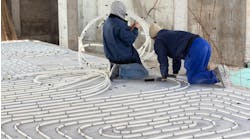Latest from Radiant
eBook: Nelson Mechanical Stories - Volume 1
Sponsored
Tibor Schuller got into radiant work from the plumbing side of the business. He credits his introduction to the technology to his father who started offering radiant systems to his customers back in the '90s.
"His was one of the first companies to use it in tract housing," Schuller says, "and he got good with it. From there it was a natural progression to laying pipe in basements and different areas for floor heating. And it just grew from there."
Schuller increased his own expertise in radiant bit by bit, reading whatever he could get his hands on and making time to attend manufacturer-sponsored seminars. He's a big fan of the technology—both the efficiency it can deliver and the level of comfort it can provide. "You're not supposed to even feel it if you're doing it right," he says. "Whether you're' in a t-shirt or a sweater, you're just comfortable."
In fact, he's used his own home to experiment with various radiant systems and techniques. "We used the SharkBite big diameter fittings for the boiler loop," Schuller says, "and we have a little bit of everything on the system. We have snowmelt, we have patio snowmelting on the third floor, we have the driveway snowmelt, we have in-floor heating throughout as well as some air-handing units."
Living and working as he does, just north of Toronto, Schuller was quick to add snowmelt to his company's offering. Initially, most of his customers were on the commercial side. "Snowmelt has, in just the last three or four years become really popular on the residential side," Schuller says. "Before, it was mainly on commercial applications, ramps for buildings, certain manufacturers who needed the floor to remain a certain temperature. I remember years before doing some work with my dad at a battery factory and the floor had to remain a certain temperature so the batteries didn't lose charge... we've been starting to see it spec'ed at larger scales over the last four to six years."
And, of course, there's parking. Apart from the expense of snow removal, a building with snowmelt doesn't have to allocate space for large piles of snow once its been removed. It all adds up to more parking, lower insurance rates (due to fewer slips and falls) and a more valuable commercial setting.
It was only a matter of time before some of Schuller's residential customers decided they wanted those advantages as well. One in particular was a renovation of an older home that was expanding from 28,000 sq. ft. to 34,000 sq. ft. The revamp included both an indoor swimming pool and an outdoor swimming pool.
The clients also wanted 15,700 sq. ft. of radiant snowmelt for the driveway and walkways, and they turned to Schuller to get the work done.
"The pipe diameters were massive," Schuller says. "Inch-and-a-quarter for some of the supply lines, the branch off the boiler was 3". We had two manifolds. We used all SharkBite push fittings." To power the system Schuller used Neotherm boilers from Bradford White, along with a Thermal 2000 buffer tank. "We didn't want to send send straight cold water to the boilers so we kept the buffer tank at a certain temperature," Schuller explains. They even used a space heater in the boiler room to control temperature and condensation.
For circulation, Schuller used Star Series pumps from Wilo with pump controllers from Taco Comfort Solutions and a Tekmar snowmelt controller to regulate the boilers.
Schuller has long been a fan of the SharkBite push-to-connect fittings for radiant applications. "The SharkBite product, for the most part, it goes together very easy," he says. "Let's say you're up high in the ceiling, where there's a lot of combustible material—wood, insulation, whatever. Normally, if you're soldering it you'd have to get your torch in there and risk setting the place on fire."
SharkBite proved especially helpful on this particular snowmelt project. "There was this one spot where the concrete guys did their work and damaged the pipe," Schuller says. Typically that would mean breaking through the layers of concrete to get a crimp on the pipe. But with the SharkBite, "We were able to dig a hole and clean the pipe, cut it further back underneath—like maybe a foot, two feet in—and then just push the fitting on," Schuller explains. "That's one application where I don't think we could have done it any other way."
The integrity and dependability of the SharkBite connection is a big selling point for Schuller. It's also why he's a fan of the company's EvoPEX solution. "I think they are the coolest things," he says. "They seal from the inside, so when I'm burying stuff in the ground, sometimes just a crimp fitting doesn't feel right. Having these fittings, being able to use them in a floor installation, even 100% glycol, it has been really positive."
And the confidence he feels actually works as a selling point for customers. "The same question people always ask is, well, what happens when it leaks?" Schuller says. "People are so worried, especially at the beginning when they take ownership of something and its their first home. So when you have this fitting and you can say, here, here's your peace of mind—it's good stuff."
Steve Spaulding | Editor-inChief - CONTRACTOR
Steve Spaulding is Editor-in-Chief for CONTRACTOR Magazine. He has been with the magazine since 1996, and has contributed to Radiant Living, NATE Magazine, and other Endeavor Media properties.




